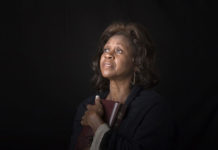The pings of a hammered dulcimer fill a suburban American living room with worship choruses. Metal folding chairs creak. The aroma of coffee wafts through the air. A longhaired dachshund settles on the sofa with two teenage girls and their father. A toddler wanders among the knees of the group as they sing together.
“Can we do a hymn?” someone asks. Used Baptist hymnals are passed around, and the group begins a cappella. By the fourth verse of “Fairest Lord Jesus,” the hammered dulcimer has joined the melody line, and the singers have broken into parts.
A few minutes later, the worship time ends, and the group begins to share: business successes, mission trip plans, stories of outreach during the week, the heartache of a 16-year-old boy battling leukemia. Then they pray.
Elder and teacher Tom LeCompte announces a break. A few people trickle into the kitchen for coffee refills or corn chips—a taco lunch is soon to follow. When the group of 17 reassembles for the teaching time, LeCompte asks, “In what ways can our families bring glory to God?” A cell phone rings, and someone steps out the front door to take the call.
Meet New Covenant Fellowship in Louisville, KY. It’s casual. It’s free flowing. It’s organic. And so is church to an estimated thousands who are abandoning traditional churches and pews for living rooms and couches.
In an impersonal and fast-paced world, they seek an intimacy that’s often difficult to find.
A Growing Movement?
An “organic church” can be held any place where life happens, meaning…anywhere. In someone’s living room. A neighborhood park. Even a local coffee shop. And it can be called many things: house church, simple church, organic church, a huddle. That’s part of the beauty of organic churches—they’re hard to define and generalize. It’s also the primary reason why tracking exact numbers for the organic church movement is next to impossible. Nevertheless, the research we do have points to a trend.
According to Barna research, in 2004 6% of U.S. adults engaged in a house church—defined by company President George Barna as an aggregation of people regularly meeting in a house, fulfilling the functions of a traditional congregation—at least once a week. And 5% more did so at least once a month. That 11% total rose to 13% in 2005.
In his latest book Revolution (Tyndale), Barna asserts that “millions” of Christians are now finding not only more intimate relationships with believers, but life transformation outside church sanctuaries—what he refers to as the Revolution. Organic churches are one way these Revolutionaries are revolting, he says. Moreover, 77% of Christians who don’t attend church say they’re still committed to their faith; yet, recent research reveals church attendance is waning. The American Church Project from church planter and researcher Dave Olson reports that on any given Sunday, only 17.7% of the 2004 American population—52 million of around 294 million—go to church.
Revealing Commitment
So are more people staying committed to their faith through organic churches?
Missiologist and North American Mission Board (namb.com) Research Team Director Ed Stetzer thinks the answer might be ‘yes.’ In his recently released book Planting Missional Churches (Broadman & Holman), he references an annual House Church Conference in Colorado. According to Stetzer, the conference drew more than 400 people last year, and more than 100 network leaders attended its pre-conference. Stetzer also cites global house church trends-watcher Wolfgang Simpson’s estimate of 5,000 house churches in North America, and Barna researcher Thom Black’s estimate of 1 million people involved in house churches in North America.
“We see an increase in models of church that reject certain organizational models, embracing what are often called ‘incarnational’ or ‘house’ models,” says Stetzer. “They are responding to the fact that after decades of trying fresh ideas in innovative churches, North America is less churched, and those that are churched are less committed.”












